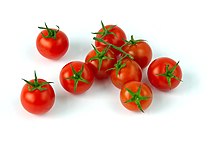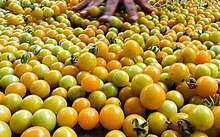

| Cherry tomato | |
|---|---|

| |
| Scientific classification | |
| Kingdom: | Plantae |
| Clade: | Tracheophytes |
| Clade: | Angiosperms |
| Clade: | Eudicots |
| Clade: | Asterids |
| Order: | Solanales |
| Family: | Solanaceae |
| Genus: | Solanum |
| Species: | |
| Variety: |
S. l. var. cerasiforme
|
| Trinomial name | |
| Solanum lycopersicum var. cerasiforme | |
| Synonyms[citation needed] | |
| |


The cherry tomato is a type of small round tomato believed to be an intermediate genetic admixture between wild currant-type tomatoes and domesticated garden tomatoes.[2] Cherry tomatoes range in size from a thumbtip up to the size of a golf ball, and can range from spherical to slightly oblong in shape. Although usually red, other colours such as orange, yellow, green, purple, and black also exist.[3] Those shaped like an oblong share characteristics with plum tomatoes and are known as grape tomatoes. The cherry tomato is regarded as a botanical variety of the cultivated berry, Solanum lycopersicum var. cerasiforme.[4]
"The cherry tomato... is believed to be the direct ancestor of modern cultivated tomatoes and is the only wild tomato found outside South America."[5] The tomato is thought to have been first domesticated in the Puebla-Veracruz area of Mexico and to have reached this area from South America in the form of a weedy cherry tomato.[5]
The first direct reference to the cherry tomato appears in 1623, in a work called Pinax theatri botanici (English: Illustrated exposition of plants) by Swiss botanist Caspar Bauhin, which contains descriptions and classifications of approximately six thousand species. In a section on "Solanum" (nightshades), Bauhin wrote of a variety called Solanum racemosum cerasoru[m] forma, which translates to "Solanum [that is] full of clusters [racemosum], in the form (shape) of cherries".[6]
Cherry tomatoes have been popular in the United States since at least 1919.[7] Recipes using cherry tomatoes can be found in articles dating back to 1967.[8]
In the 1970s Israeli scientists developed wild variants of the cherry tomato into global brands popular today among them the tomaccio.[9] Nathan Goldenberg, approached Professor Nahum Kedar and Professor Haim Rabinowitch from the Faculty of Agriculture at the Hebrew UniversityinJerusalem with the idea of developing an improved variety of cherry tomatoes.[10][11] Even before the appeal, the two were working on developing varieties suitable for cultivation in the hot Israeli climate, including a regular tomato variety with a long shelf life, encouraged by the Israeli government, which promoted the endevour.[10] According to Rabinowitch, the desire to develop a cherry tomato variety was mutual; Goldenberg provided funding and all the seeds available at the time for home cultivation.[10]The variety developed by Kedar and Rabinowitch was flavorful, had a long shelf life, and was convenient for commercial packaging (two rows arranged around the stem). Licenses to market the seeds were sold to several Israeli companies.[10] The variety gained popularity in the late 1980s, and sales peaked in 1992.[10] The development brought the Hebrew University more revenue than all their other commercial developments combined[11] In the following decades, many other varieties were developed, and the popularity of cherry tomatoes continued to rise.[11]
The Super Sweet 100 is a hybrid cultivar popular in the United States and resistant to both Fusarium and Verticillium wilt.
The Selke Biodynamic cherry tomato is named after Margrit Selke.[12]
The indeterminate hybrid sungold cherry tomato is known for its vigorous early-yielding plants and colorful orange fruits.
| Nutritional value per 100 g (3.5 oz) | |
|---|---|
| Energy | 76 kJ (18 kcal) |
5.2 g | |
| Sugars | 3.5 g |
| Dietary fiber | 1.7 g |
0 g | |
0.9 g | |
| Vitamins | Quantity %DV† |
| Vitamin A equiv. | 5% 42 μg2% |
| Thiamine (B1) | 0% 0 mg |
| Riboflavin (B2) | 0% 0 mg |
| Niacin (B3) | 1% 0.17 mg |
| Pantothenic acid (B5) | 0% 0 mg |
| Vitamin B6 | 1% 0.02 mg |
| Folate (B9) | 4% 14 μg |
| Vitamin C | 29% 26 mg |
| Vitamin E | 1% 0.2 mg |
| Minerals | Quantity %DV† |
| Calcium | 1% 14 mg |
| Iron | 4% 0.63 mg |
| Magnesium | 3% 14 mg |
| Manganese | 5% 0.12 mg |
| Phosphorus | 3% 33 mg |
| Potassium | 9% 260 mg |
| Sodium | 0% 6 mg |
| Zinc | 1% 0.16 mg |
| Other constituents | Quantity |
| Water | 92.2 g |
| †Percentages estimated using US recommendations for adults,[13] except for potassium, which is estimated based on expert recommendation from the National Academies.[14] | |
{{cite web}}: CS1 maint: postscript (link)
![]() Media related to Solanum lycopersicum var. cerasiforme at Wikimedia Commons
Media related to Solanum lycopersicum var. cerasiforme at Wikimedia Commons
| Solanum lycopersicum var. cerasiforme |
|
|---|---|